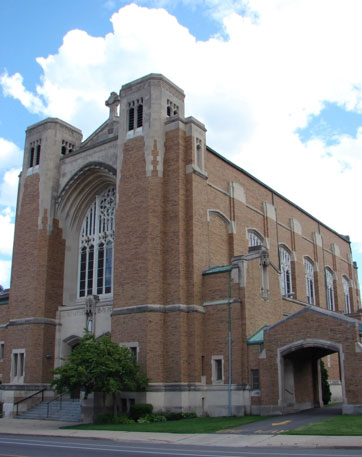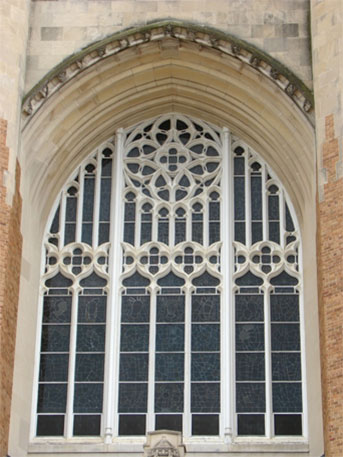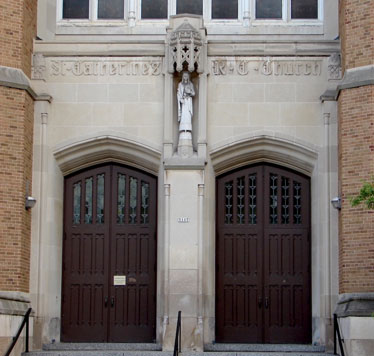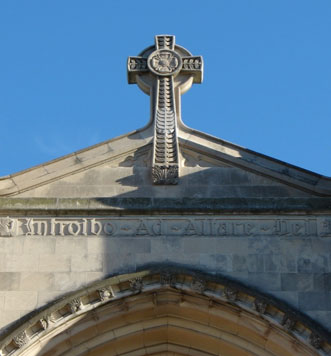50. St. Catherine’s Catholic, 1949
5101 West Center Street
Architects: William G. Herbst and Associates
The Archdiocese of Milwaukee established St. Catherine’s Parish in 1922, to serve Catholic residents of the growing area west of Sherman Boulevard. At that time, prior to the city’s post-World War II annexations, the church property was in the westernmost portion of Milwaukee. Anticipating a series of building campaigns, the parish had a general plan for the entire complex drawn up in 1923. The first building was a combined church and school, with the finished basement initially used for both classrooms and religious services. The upper floors were completed in the later 1920s. Two additional buildings, a convent and rectory, were added in 1931 and 1936, respectively. As with some of the city’s other Catholic parishes, construction of the church itself was delayed until after World War II. The buildings have a consistent look in their exterior materials and colors that is not often seen in church complexes built over the course of more than two decades. This is in part a product of the early planning for the entire complex.
Construction of the church began in the late 1940s, with dedication ceremonies in July of 1950. Like many buildings dating to the early postwar years, the church looks like it could be two to three decades older. Little was built during the depression and war years, and when building resumed after this long dormant period, architects picked up where they had left off in the 1920s. The lack of building activity resulted in a corresponding lack of stylistic development in the historical revival styles, which were also being replaced by modernism for nearly all building types at this time. (St. Mary of Czestochowa Catholic is another example of a post-World War II church that looks like it could date to the 1920s.)
St. Catherine’s is nonetheless Milwaukee’s best example of the more academic phase of the Gothic Revival that began around the beginning of the previous century. Led by East Coast architects Ralph Adams Cram and Bertram Goodhue, this later phase of the Gothic Revival exhibits a greater fidelity to the forms and proportions of Gothic churches, particularly those of the late English Gothic. Also called Perpendicular Gothic, the late English Gothic emphasizes vertical lines, most noticeably in the more simplified tracery of its windows. In Milwaukee, the earliest examples of this phase of the Gothic Revival include Plymouth Congregational of 1913 and Redeemer Lutheran of 1915. In its overall form and proportions, St. Catherine’s bears a strong resemblance to Redeemer Lutheran.
Like those two earlier churches, St. Catherine’s has a basilican plan with narrow side aisles. The central nave, however, is unusually wide. Another similarity to those two earlier churches is the use of exposed masonry rather than painted plaster in the worship space. The lower portions of the walls, and the columns that separate the nave from the side aisles, are Cordova limestone from Texas. A distinctive interior feature is the way that the Stations of the Cross are carved directly into the stone walls of the side aisles. Each station is three feet wide by four feet tall, and was carved in place after the stone walls were erected.
William G. Herbst (1885-1959) grew up in Milwaukee and studied architecture at the Armour Institute in Chicago (now the Illinois Institute of Technology). He worked in the offices of Milwaukee architects Ferry and Clas and Kirchhoff and Rose prior to forming a partnership with Edwin Kuenzli in 1919. Herbst and Kuenzli did a considerable amount of work for Catholic parishes in Milwaukee and its suburbs, designing churches, schools, convents, and other buildings. The firm continued as William G. Herbst and Associates after Kuenzli’s retirement in 1942, later changing to Herbst, Jacoby and Herbst, and finally Herbst, Jacoby and Jacoby. Commissions for Catholic churches continued to be a mainstay of the firm under its successive names.
Sources:
“Dedication is Slated at St. Catherine’s,” Milwaukee Journal, July 15, 1950, page 5, column 2.
St. Catherine’s 50th Anniversary, 1922-1972. St. Catherine’s Parish, 1972.
“St. Catherine’s New Church Majestic Edifice,” Catholic Herald Citizen, July 15, 1950, page 4, column 1.
St. Catherine’s Parish Lay-Out Well Planned,” Catholic Herald Citizen, July 15, 1950, page 10, column 4.



